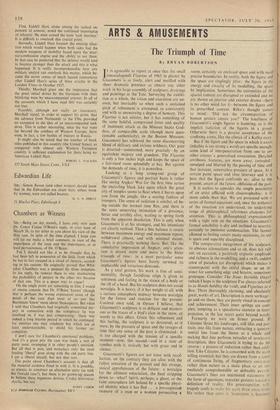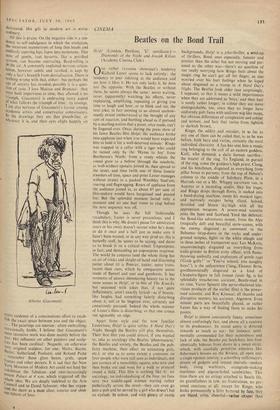ARTS & AMUSEMENTS
The Triumph of Time
By BRYAN
ROBERTSON
Ir is agreeable to report at once that the small (uncatalogued) Figurine of 1965 in plaster by Giacometti is as lively, alert and instilled with sheer dramatic presence as almost any other work in his large assembly of sculpture, drawings and paintings at the Tate. Surveying the exhibi- tion as a whole, the vision and execution are un- even, but inevitably so when such a sustained pitch of refinement is attempted, so consistently and with so unswerving a degree of honesty. This Figurine is not sinister, but it has something of the same baleful, compressed force and quality of imminent attack as the Minoan Snake God-• dess, of comparable scale (though more ques- tionable authenticity), in the Boston Museum. Giacometti has achieved the same disconcerting blend of delicacy and vicious wildness. Our gaze is diverted—summoned, more precisely—by an equiValent majesty and grandeur. The Figurine is only a few inches high and keeps the space of a fair-sized room splendidly at bay. But against the demands of time, it is powerless.
Looking at a long strung-out group of Giacometti's figures and portrait busts is rather like seeing Angkor Wat for the, first time across the -encircling black lake upon which the great city of temples seems to float when it bursts upon you from the jungle, like a searing fanfare of trumpets. The sense of isolation is similar, of be- ing outside the normal time flux, and there is the same unnerving intimation of a presence, fierce and terribly alive, waiting to spring forth from the apparent desolation. This is only when Giacometti is at his strongest, and his intentions are clearly realised. Then a fine balance is struck between maximum energy and maximum repose, withdrawal almost, and with minimal means. There is practically nothing there. But, like the cumulative impression of Angkor, one's atten- tion is drawn more and more to the bitter 'triumph of time: in a most' particular sense Giacometti's figures have barely survived its implacable and voracious demands.
As a total gesture, his work is free of senti- mentality, though fastidious reign is given to sentiment and feeling in the stance of a body or the tilt of a head. But his sculpture does not avoid nostalgia. It is heavy, if it has weight at all, with a curious atmosphere midway between nostalgia for the future and stoicism for the present. Cocteau once said, in Opium I believe, that Giacometti's sculpture is as delicate and mysteri- ous as the traces of a bird's claw in the snow, or words to this effect. Given this refinement and this feeling, the sculpture is so devoured, as it mere, by the pressure of space and the ravages of time that any sense of the past is eliminated : it is too charged with the tension of a specific moment—now, this second—and in a state, of combat with it, stoically but with grace and in silence.
Giacometti's figures are not tense with recol- lection, on the contrary they are alive with the fullest sensation of the present, and this strange, stoical apprehension of the future: a nostalgia for the ultimate emaciation, the final stripping down to—what? Spirit, perhaps; a ghost, or the faint atmosphere left behind by a specific physi- cal identity when it has fled . . . a pre-cognisant memory of a man or a woman permeating a room, certainly an enclosed space and with most precise boundaries. In reality, both the figure and the space are tinglingly alive: the figure in the energy and vivacity of its modelling, the space by implication. Sometimes the extremities of the spacial context are disrUpted or extended and we are shown an interior and exterior drama—there is no other word for it—between. the figure and its prescribed context. Rilke's thought comes to mind : 'Did not the circumspection of human gesture. amaze you'?' The loneliness of Giacometti's single figures is haunting, so is the implicit isolation of the figures in a group. Otherwise there is a passive acceptance of the confining arena, like the climax of a Kafka story.
But if the figure and 'the space in which it exists (inhabits is too strong a word) are specific enough, some kind of interpenetration from one to an- other creates 'a generalised association. Detailed attributes, features,. are worn away, corroded : smudged and blurred by the passing of time and that insistent, remorseless pressure of space. At a certain point space' and time intersect and it is (sere that the figure confronts us : alive. to the present, aware of the future, oblivious of the past.
It is useless to consider the simple possibility of an artist afflicted with claustrophobia: it IS more subtle than that. We are presented with a series of formal equations andi once the aesthetics of the situation are understood, - an underlying range of philosophical references clamours for attention. This' is philosophical expressionism with a tight rein on the emotions. Giacometti's formal sensibility is dry and inclined to severity, certainly to immense condensation. The licence allowed to feeling covers many' occasions, its use is spate. and superbly disciplined.
The .comparative meagreness of his sculpture, its obvious attenuations and so on, does not rule out; 'on occasion; a positively orgiastic amplitude and richness in the modelling, and a swift, sudden sense of paradox (or disruption) which makes a counterpoint with the initial shape, or an in- stinct for something edgy' and bizarre, sometimes grotesque. Consider:The • Nose, Invisible .Object (which I hope is the sculpture I've always referred to as Hands holding the void), and Figurines in a Box. Three thoroughly alarming, and absolutely great, works of art. Description is mere verbiage : go and see 'them, they are purely visual in concept and achievement. Their inner springs are corn- plex;tempting as a speculative exercise in inter- pretation, in the last resort quite beyond words.
Formerly we were on firmer ground. 11 Ceianne thrust his landscapes, still lifes and por- traits into life from nature, extracting a quintes- sential line from the theme as a whole and making that line perform miracles of revelatory description, then Giacometti is trying to do the reverse: a process of reduction rather than addi- tion. Like Cdzanne, he is concerned with the frost telling essentials but they are drawn from a seito of continuous living, of fragmentary exist, n::• rather than nature 'as a static place or an im- mediately comprehensible or definable per;.m. Giacometti's lines are murmured statements the form of questions, tentative gestures toward a definition of reality. His preoccupation Frith tragedy. tends to make his work draw away front life rather than enter it. Sometimes it become
desiccated. His gift to modern art is extra- ordinary.
All this is praise. On the negative side is a ten- dency to self-indulgence in- which the etiolation, the recurrent mannerisms of long thin heads and endlessly tapering legs, lapse into monotony. This note of gentle, taut hysteria, like- a petrified scream, can become enervating. Bead-telling is in the air. A constantly exploited nervous articu- lation, however subtle and rarefied, is kept by Only a hair's breadth from devitalisation. There is nothing wrong.with that, either: but perhaps the age of anxiety has receded, possibly it is a ques- tion of taste. I love Matisse and Brancusi : they Were both-impervious to time, they allowed it no tr,nimph. Giacometti is embracing every aspect 01 what follows the triumph of time : its revenge. I am also nervous of GiacOmetti's favour among academic.: artists and conservative connoisseurs. In the drawingS they see that plumb-line, or Whatever, it is, and their eyes alight happily on • Alberto Giacometti.
,e,verY evidence of a conscientious effort to estab- lish the exact space between you and the object.
• • • The paintings are uneven: often enthralling, occasionally feeble. I believe that Giacometti's most inventive work was done mainly before the War. His influence on other painters and sculp- tors has been cardinal: Noguchi, an otherwise very original sculptor, for one; Matta, Bacon, "tier, Sutherland, Paolozzi, and Roland Piche „ -remember those glass boxes, grids, space frames and other devices. It is sad that the New York Museum of Modern Art could not lend the exhibition the fabulous and ever-increasingly Potent Palace at 4 a.m. which triggered off the whole idea. We are deeply indebted to the Arts (-:-ounvil and to David Sylvester, who has organ- ised the show as a most clear, concise and obvi- °us labour of love.





























 Previous page
Previous page